The Old Greek School in Ahtopol – a creative base of the National Academy of Arts, a remarkable example of a cultural and historical monument and a center for art and heritage
- Stefan Ivanov

- Aug 6
- 11 min read
Updated: Aug 22
The old Greek school in Ahtopol is much more than an ordinary architectural landmark, which I will now present to you with great pleasure.

The school is a living monument that reveals the rich cultural and educational history of the city.

This iconic building, perched on the easternmost part of the St. George Peninsula, on the eastern edge of the city, rises on the cliffs in close proximity to the sea..

It is a symbol of Ahtopol's multi-layered historical heritage and reflects the intertwining of different ethnicities and cultures over the centuries.

The school has witnessed significant historical events and changes that have shaped the face of the region.

Along with the history of the old Greek school, I will also reveal to you its unique architectural features, I will also tell you about its diverse educational and social role in the past, as well as its current function as an important cultural center and creative base, housing truly unique exhibitions, which I viewed with great pleasure.

Ahtopol, located on the picturesque Kerata Peninsula, has deep historical roots that date back to the Neolithic Age.
Archaeological research shows that the area was inhabited by the Thracian tribe of Tini during the Iron Age.

The city itself was founded as a Greek colony around 430 BC. These early settlements and Greek origins highlight the long-standing and significant Greek presence in these lands, which has left a lasting mark on the culture and development of the region.
In this historical context, the Greek school is an important symbol of the population that inhabited these lands before the Bulgarians finally regained control over them.

The building is not just an educational institution, but reflects the complex ethnic and political history of the region, where different cultures have coexisted and left their legacy.

Its existence and transformation are directly related to the demographic and political changes that have occurred in Ahtopol over the centuries.
Creation
The construction of the old Greek school, which is considered the first school in Ahtopol, began in 1898 and was completed at the beginning of the 20th century.

This large-scale initiative and its funding are the work of the organization "Sons of Agathoupolis in America" and Greek expatriates in the United States.

This fact is more than a simple financial detail; it reveals the deep connection and commitment of the Greek diaspora to their community in the homeland.
During a period of significant ethnic and political change, especially in the Ottoman Empire and beyond, investment in an educational institution was a strategic act to maintain cultural identity and language.
This is a vivid example of transnational cultural transfer and solidarity, demonstrating how emigrant communities play a key role in the development and preservation of the cultural heritage of their homelands. This philanthropy was combined with a long-term vision for the future of the Greek community in Ahtopol.
Architecture and Construction
The building was erected by Bulgarian craftsmen based on a project by Greek architects. This joint work between Bulgarian contractors and Greek designers symbolizes the cultural interaction and cooperation characteristic of the region during this period.

The location of the school is strategic - it was built on the site where the northern gate of the ancient fortress was located.

The construction of a new significant building on the remains of an ancient fortress structure is not just a choice of location, but demonstrates the continuity and significance of the terrain throughout different eras.

This fact suggests the possibility of discovering archaeological finds during construction or subsequent excavations.

Indeed, excavations around the building have uncovered finds spanning the period from the Late Iron Age to the present day. This makes the building itself part of a larger archaeological context and highlights the multi-layered history of Ahtopol, where each era leaves its mark on the previous one.
The architectural features of the school include extremely thick walls of 60 cm, which ensures the strength and stability of the structure.

All corners of the walls, windows, portal and roof frieze are lined with red bricks, which were specially brought by barges from Marseille.

This detail speaks to the quality of the construction and the importance attached to the building, as well as Ahtopol's connections with the wider Mediterranean world.

One of the most remarkable aspects of the design is its functional flexibility.

The six classrooms were divided by wooden walls that could easily be dismantled to convert into a large hall with a podium and a tribune at the back.

This adaptability is indicative of an extremely flexible and forward-thinking architectural design for its time. It reveals that the school was intended not only as an educational institution, but also as a key public space – perhaps for meetings, cultural events, or even as the city’s senate. This multifunctionality underlines the building’s central role in the life of the Greek community, far beyond its purely educational functions.
Original purpose and educational role
The building was intended to house a sixth-grade school, which represented a significant level of education for the period, and at the same time served as the city’s senate.

The first classes began at the beginning of the 20th century, with teachers invited from Greece for this purpose.

This ensures high quality of education and maintenance of the Greek language and culture.
Transition to a Bulgarian school
A significant change in the history of the building occurred after 1915, when the Greeks left the city.

This is a direct consequence of historical events in the region, probably the Balkan Wars and the subsequent changes in the borders and ethnic composition of the population.

Despite this demographic and political transition, the building retains its educational function.

A Bulgarian school was opened there, which was initially a three-grade school, supported by parents' funds.
It later expanded to four grades, and in 1923 it became a junior high school. This transformation demonstrated the resilience of the educational institution and its adaptability to the changing needs of the population, while emphasizing the continuity of knowledge and culture, regardless of the ethnicity of the students.
Today, the Greek School has been declared a cultural monument of local importance and has been reconstructed, which emphasizes its exceptional historical and architectural value.
The Greek School Today - a Center for Art and Heritage
Today, the old Greek School no longer functions as a traditional educational institution.

The transformation of a non-functioning school into a creative base for the National Academy of Arts (NAA) is an excellent example of adaptive reuse of cultural heritage.
Instead of the building falling into disrepair or being demolished, it has been given new life and continues to serve community and educational purposes, albeit with a different focus.
This approach not only ensures the physical preservation of the monument, but also maintains its vitality and relevance, integrating it into contemporary cultural life.
This is a sustainable model for the preservation of immovable cultural heritage, which ensures that historic buildings remain an active part of the community.
Creative base of the National Academy of Arts (NAA)
As the creative base of the National Academy of Arts (NAA), a summer academy is held here every year, within the framework of which teachers and students from Bulgaria and abroad gather to create.
This activity keeps the building’s connection with education and art alive, turning it into a center for contemporary creativity and the exchange of ideas.
Permanent exhibition and museum collection
The Greek school houses a permanent exhibition, which is a museum collection. It displays archaeological finds discovered on the territory of Ahtopol. These finds cover an impressive period from the Late Iron Age to the present day, revealing the thousand-year history of the settlement.
The exhibition also includes works by authors who participated in the summer academies of the National Academy of Arts.

Combining archaeological finds that testify to Ahtopol's millennial history with contemporary art created within the framework of the NHA's summer academies is a powerful curatorial approach. This creates a unique dialogue between the past and the present, demonstrating the continuity of the creative spirit and cultural development of the place.

The school is not just a repository for artifacts, but a dynamic space where history inspires contemporary art, and art breathes new life into the historical context.

This highlights the museum's role as a place of interpretation and connection between eras, offering a multi-layered cultural experience.
Outdoor Exhibition
In addition to the indoor exhibition, an outdoor exhibition of wooden sculptures is located in the courtyard of the Greek School. This open-air gallery further enriches the cultural experience of visitors by offering interaction with art outdoors.
The old Greek school in Ahtopol is a remarkable example of a cultural and historical monument that has transcended its original purpose.

From its establishment in the early 20th century as an educational and community center for the Greek community, funded by the diaspora and built with an innovative design for its time, to its transformation into a Bulgarian school after demographic changes in 1915, and subsequently into a cultural monument, the building has undergone numerous transformations, reflecting the dynamic history of Ahtopol. Its construction on the site of an ancient fortress gate and the archaeological finds discovered around it further highlight the multi-layered history of the place.

Today, through its adaptive reuse as the creative base of the National Academy of Arts and host to unique exhibitions, the school continues to be a vital cultural center. It synthesizes the city’s archaeological heritage with the achievements of contemporary art, serving as a bridge between the past and the present. This combination of historical artifacts and contemporary works creates a dynamic space for cultural dialogue and inspiration.

The Old Greek School is not only a testament to Ahtopol’s multicultural history, but also an inspiring example of how cultural heritage can be preserved, reimagined and integrated into modern life, continuing to enrich the community and attract visitors. It is a living lesson in history, architecture and cultural continuity that continues to grow in importance.
How to get to Ahtopol?
Ahtopol (Greek: Αγαθούπολιο) is a town on the southern Black Sea coast of Bulgaria, in the Tsarevo Municipality, Burgas District.
Uncover the thousand-year history of the seaside town and visit its hidden treasures HERE.
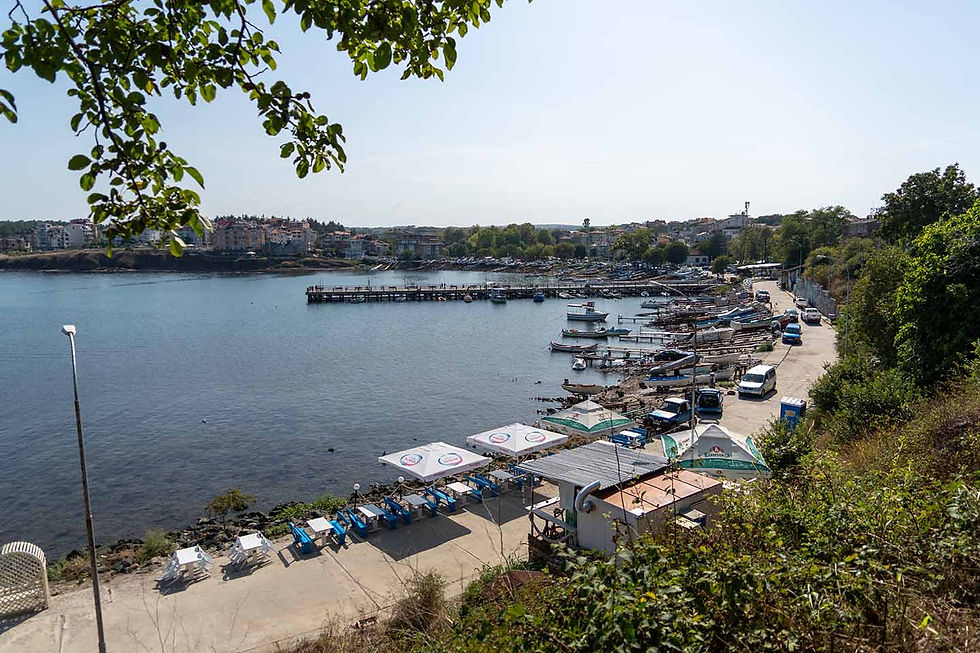
The third-class republican road III-9901 passes through Ahtopol, which leads northwest through the village of Varvara to a connection near the town of Tsarevo with the second-class republican road II-99 and along it to Burgas, and southeast through the village of Sinemorets it leads to the village of Rezovo, where it ends.

There is no air transport in Ahtopol. The nearest airport is Burgas Airport.
Ahtopol is located:
460 kilometers (about 4 hours and 44 minutes by car) from the capital
328 kilometers (about 3 hours and 34 minutes by car) from the city of Plovdiv
207 kilometers (about 3 hours and 17 minutes by car) from the city of Varna
77 kilometers (about 1 hour and 09 minutes by car) from the city of Burgas
Ahtopol is located about 15 kilometers (about 18 minutes by car) southeast of the municipal center of Tsarevo and about 17 kilometers (about 21 minutes by car) north-northwest of the southernmost Bulgarian settlement on the Black Sea - the village of Rezovo, near which the state border with the Republic of Turkey passes.
The city is located on an abrasion terrace on a rocky peninsula between Cape Ahtopol and Cape Sveti Yani.
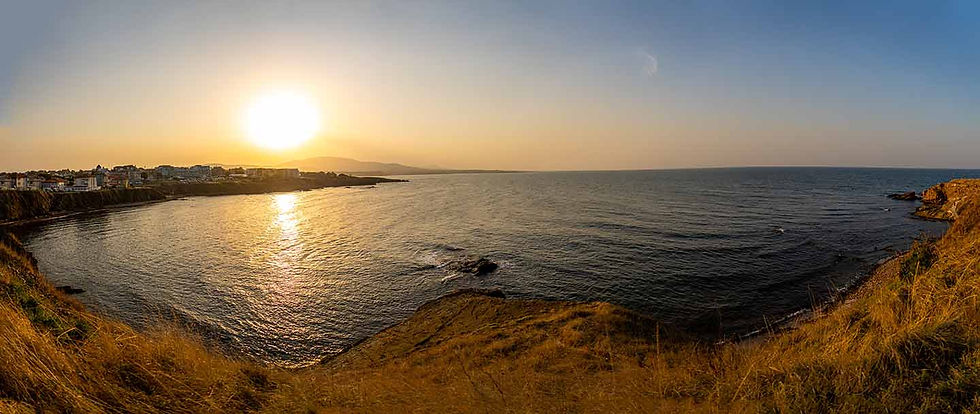
To the west, right next to the city, the branches of the Strandzha hill Bosna reach, with the highest peak Papija (501.4 meters).
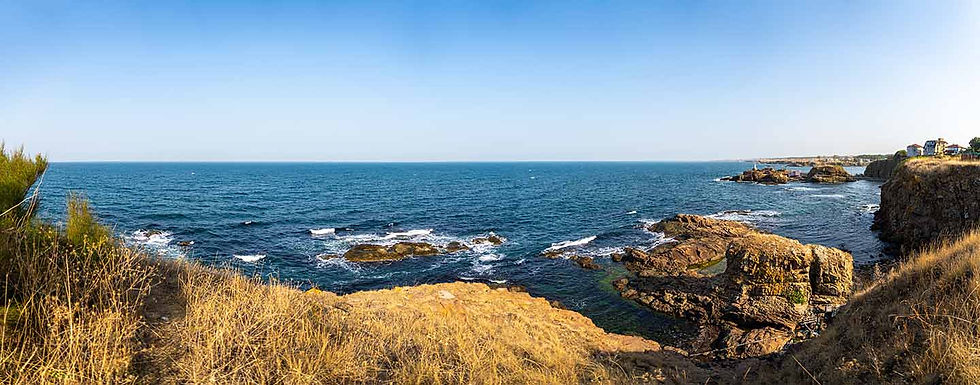
About four kilometers to the south, near the village of Sinemorets, is the mouth of the Veleka River.

The altitude in the city at the "Holy Assumption of the Virgin Mary" church, which rises directly opposite the port, is about 10 meters, in the southwest it increases to about 30 - 35 meters.

I tell you about the Church of the Assumption of the Virgin Mary in Ahtopol HERE.
The climate is continental-Mediterranean with a strong Black Sea climatic influence - mild winters - the mildest winter in Bulgaria, hot summers, early spring and a long and warm autumn.

Ahtopol has a humid subtropical climate (Köppen climate classification) bordering on a Mediterranean climate with limited continental effect.
Ahtopol is a seaside resort with hotels, holiday villages and bungalows, located mainly in the Korosiata area, west of the city, restaurants, numerous guest houses, entertainment venues and campsites.
The beach near the Korosiata area, called the Central Beach of Ahtopol, is with fine sand and dunes, wide, with a length in the territory of Ahtopol of about 1400 meters, and together with the beach, continuing to the northwest in the territory of the village of Varvara - a total of about two kilometers. The coastal seabed is shallow.
In addition to the central beach, there are a series of small beaches in the territory of Ahtopol.
The city is within the territorial scope of Strandzha Nature Park.

In the northern part of the port of Ahtopol stands the Ahtopol Lighthouse - the white guard of the port.
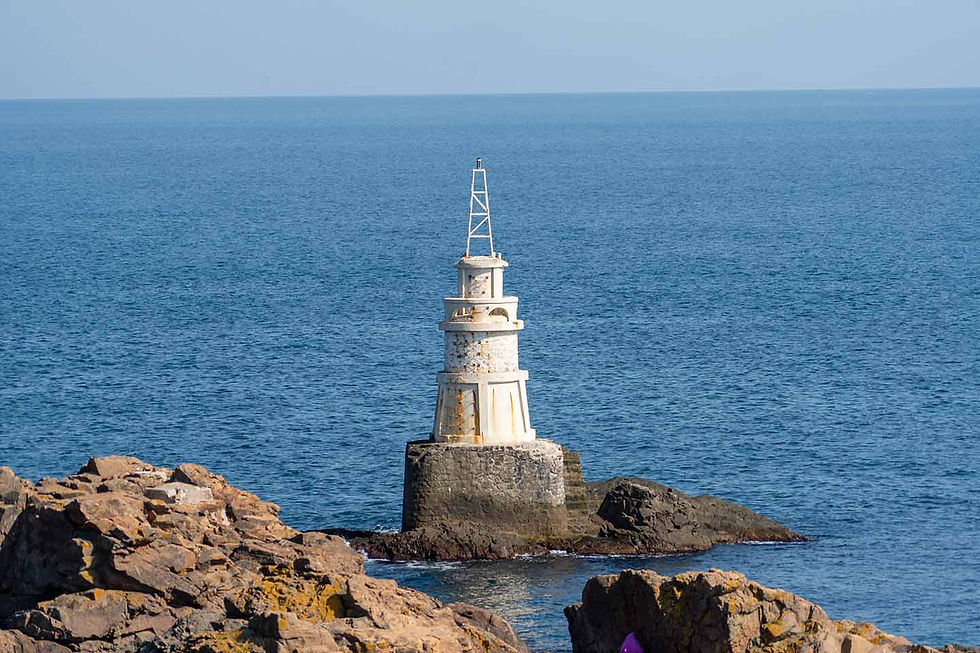
I tell you about the Ahtopol Lighthouse – the white guard of the port HERE.
On the site of today's city of Ahtopol, settlements have existed since the Neolithic Age, and during the Iron Age the region was inhabited by the Thracian tribe of Tini.
As a city, Ahtopol was founded around 430 BC by Greek colonists from Athens, and it is assumed that its founding is related to the actions of Pericles in the Black Sea regions.
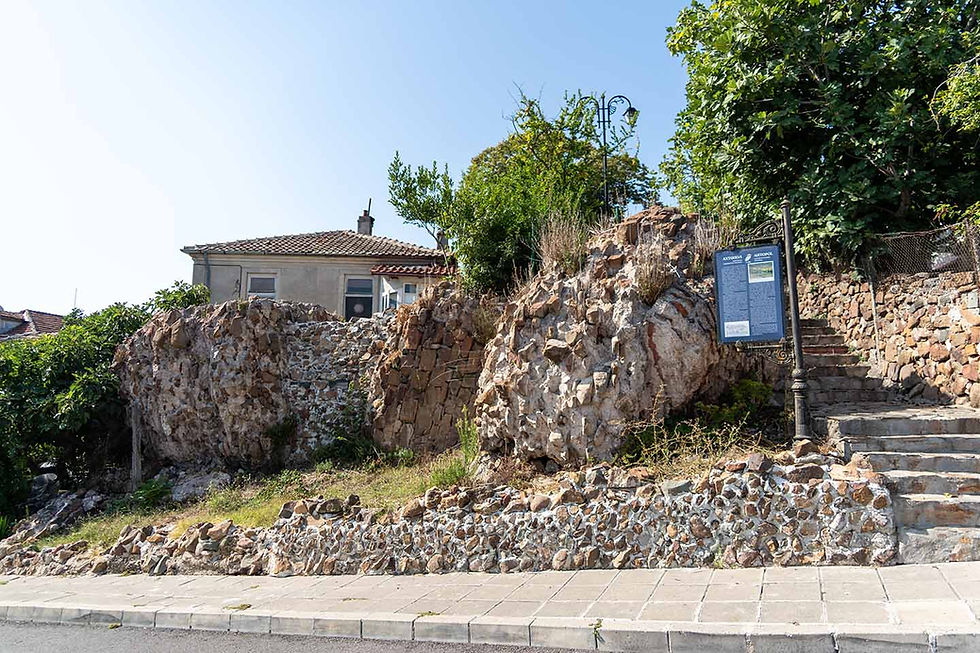
The city became a trading center, with coins being minted there.
After the barbarian invasions of the 5th - 7th centuries, the city was rebuilt by the Byzantine commander Agathon, who called it Agathopol.
During the Middle Ages, Agatopolis was included in the territory of Bulgaria several times.
I tell you about the late antique and medieval fortress in Ahtopol – the city of love and happiness Agatopolis HERE.

You can see the fully preserved church "Holy Ascension of the Lord", built in 1776, remains of the monastery "St. John" (St. Yani) from the 12th century, as well as parts of the defensive fortress wall that surrounded the city's citadel, built by Thracians, Romans and Bulgarians, ruins of which can now be seen throughout Ahtopol.
I tell you about the temple monument "Holy Ascension of the Lord" - one of the oldest and most significant architectural monuments in Ahtopol HERE.
The rich historical past of the region is told by the priceless exhibits displayed in the building of the old Greek school, which has today been converted into a museum, as well as the extremely interesting museum collection of the Public Collection "Anchor Museum" in Ahtopol - an immersion in the thousand-year-old maritime tradition with a great love for the sea.
I tell you about the Public Collection "Anchor Museum" in Ahtopol - an immersion in the thousand-year-old maritime tradition with a great love for the sea HERE.
How do you get to the old Greek school – the creative base of the National Academy of Arts?
The old Greek school stands in the easternmost part of the St. George peninsula, at the eastern end of Ahtopol, rising on the rocks in close proximity to the sea.
You can leave your cars near "Briz" Street and "Cherno More" Street, where a convenient free parking lot has been built.
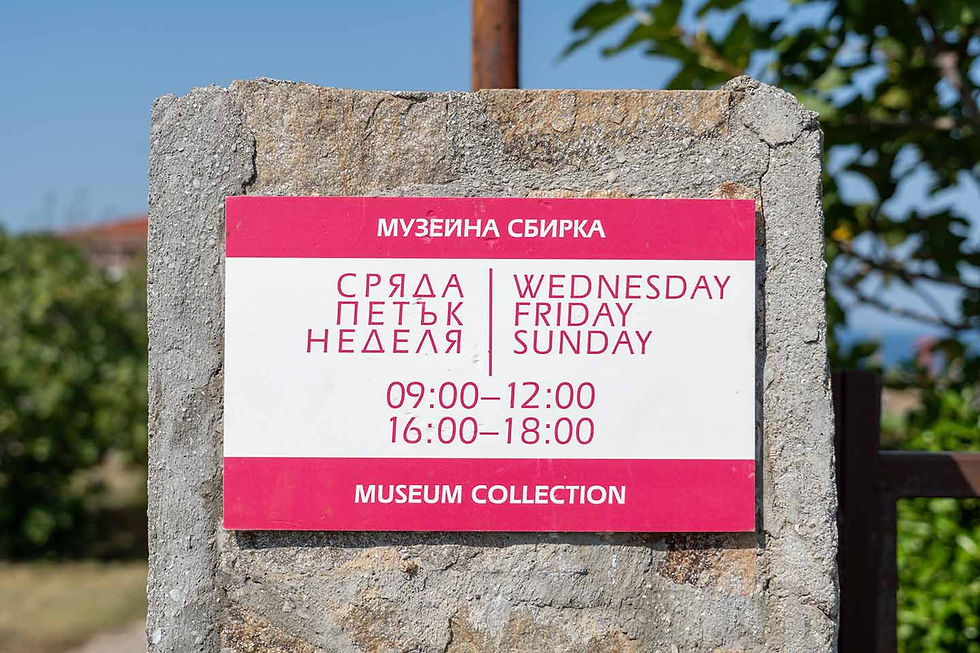
The museum collection is available for viewing on Wednesdays, Fridays and Sundays, between the hours of 09:00 and 12:00 and from 16:00 to 18:00.

This information is key for anyone planning to visit the site and immerse themselves in its history and cultural richness.
You are reading an ad-free blog – fully focused on the content!
I remind you that you can read all my posts here – in "Photo Moments", without being interrupted by a single annoying ad, because "Photo Moments" is a place without ads!
I made the important decision to make "Photo Moments" ad-free so that my site can load much faster, the content I present to you can be as clean as possible, and your experience in "Photo Moments" can be the best possible!
If you appreciate everything I do, you can support me HERE or by following the gold star below.
Thank you!
And finally, my dear friends,
you shouldn't miss to check out
the special album with photo moments –
discovered, experienced, filmed and shared with you!








































































































































Comments